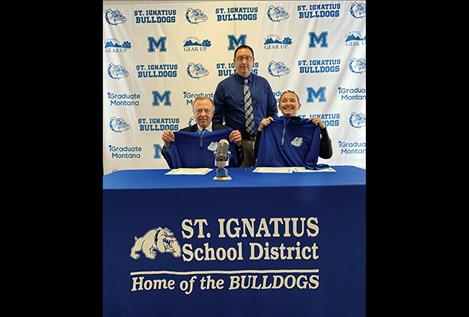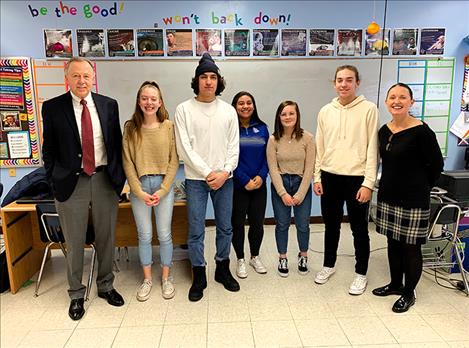St. Ignatius High School recognized for record graduation rates
Hey savvy news reader! Thanks for choosing local.
You are now reading
1 of 3 free articles.
ST. IGNATIUS – In the past few years, the St. Ignatius School District has increased their graduation rate by about 13 percent, causing state officials to take notice of the numbers and other achievements.
During the 2013-14 school year, the St. Ignatius High School had a graduation rate of 77 percent, according to Montana Office of Public Instruction data. The percentage went up to 87 percent in 2015. A small dip occurred in 2016 when the percentage went to 82 percent, but the upward trend continued into 2018 with a graduation rate rounded to 90 percent. The St. Ignatius School District currently has a graduation rate higher than the state average, which is at 86 percent.
On Wednesday, Angela McLean, who works for the Office of the Commission of Higher Education, visited St. Ignatius to find out what the school is doing to increase the numbers. The school’s progress was especially important because they are participating in the iGraduate Montana initiative.
The initiative seeks to increase high school graduation for students and expand workforce development activities. The program is sponsored by the Office of the Commissioner of Higher Education, the Dennis and Phyllis Washington Foundation, the Office of Public Instruction and the Montana Department of Labor and Industry. The Dennis and Phyllis Washington Foundation provided the Office of the Commissioner of Higher Education with a $650,000 grant to fund the iGraduate initiative for at least four years.
Fifteen schools across Montana were chosen from 40 applicants to receive the grant. Locally, the St. Ignatius High School and the Polson High School were both chosen as successful applicants for the 2018-2019 grant. McLean and officials plan to visit other grant recipients this spring.
McLean said schools across the state are doing a variety of things with the initiative to ensure more students graduate from high school. “One common thread throughout each model is parent and community engagement,” she said. “This engagement is critical because the job of student success belongs to everyone.”
St. Ignatius was awarded $10,000 in the last grant cycle. Superintendent Jason Sargent said the school used the funding to support current programs including their ninth grade transition program to help new high school students adjust to higher-level learning, the Montana Behavioral Initiative that flags student if they start to fall behind academically and the science and technology-based STEAM (science, technology, engineering, art and math) learning programs.
“Our increased graduation rates can’t be attributed to one thing,” Sargent said. “A number of things came together to create that success. We can attribute it to the many systems in place and the administrators, teachers and students doing a wonderful job. It’s also due to the partnership we have with the community. We have businesses and families involved with the school and that makes a difference.”
Success didn’t happen overnight. “The school has worked to chop down the dropout rates and find systems to help students stay in school. I think one of the things that finally worked was to engage students and get their input into their education. This wouldn’t be possible with just administrators. The principals, teachers, and students have worked as a team to create change.”
During McLean’s visit, she noticed several programs she thought attributed to the school’s success including senior graduation projects, college visits and fall and spring career fairs. “In fact, the efforts of their grant are throughout their school and their programs,” she said. “I think that is what is so exciting about their work. They have iGraduate efforts embedded in almost everything they do.”
McLean said her visiting group also learned that the student success and school completion is due in part to the school’s culture. “Through programs like GEAR UP, MBI and Link Crew, students are engaging in unique and powerful ways to support each other and their community,” she said. “This culture is one of support for all students and the fact that it is working is reflected in the data.”
The Office of the Commissioner of Higher Education and the Dennis and Phyllis Washington Foundation created the iGraduate initiative in partnership with the Office of Public Instruction and the Montana Department of Labor and Industry to build on the work of Graduation Matters Montana, which resulted in the state’s highest graduation rate from 80 percent in 2010 to 86 percent in 2017.
The iGraduate initiative is focused on high school graduation, linking students with high demand career pathways in Montana and connecting students with post-high school education opportunities at Montana colleges or apprenticeship programs.
“Montana is facing some serious challenges over the next ten years to address anticipated workforce shortages due to our aging population and strong economy. This grant will play a vital role in helping students understand the importance of graduating from high school and continuing on to either a college or an apprenticeship program,” said Commissioner of Higher Education Clayton Christian in a press release.
Mike Halligan, executive director of the Dennis and Phyllis Washington Foundation, was at the school to talk with the students about the importance of graduating. He has said that it is important that we address longer-term workforce development issues.
McLean said the need for a skilled workforce still guides the iGraduate program. Sargent is also focused on that goal. He said education is changing and turning towards a focus on giving students skills to compete in the workforce.
“We want to prepare students for jobs so they can keep up with a changing world,” he said. “There will be jobs for them that haven’t even been created yet, and we want to give them the opportunity to prepare for those jobs by working towards graduation.”

















